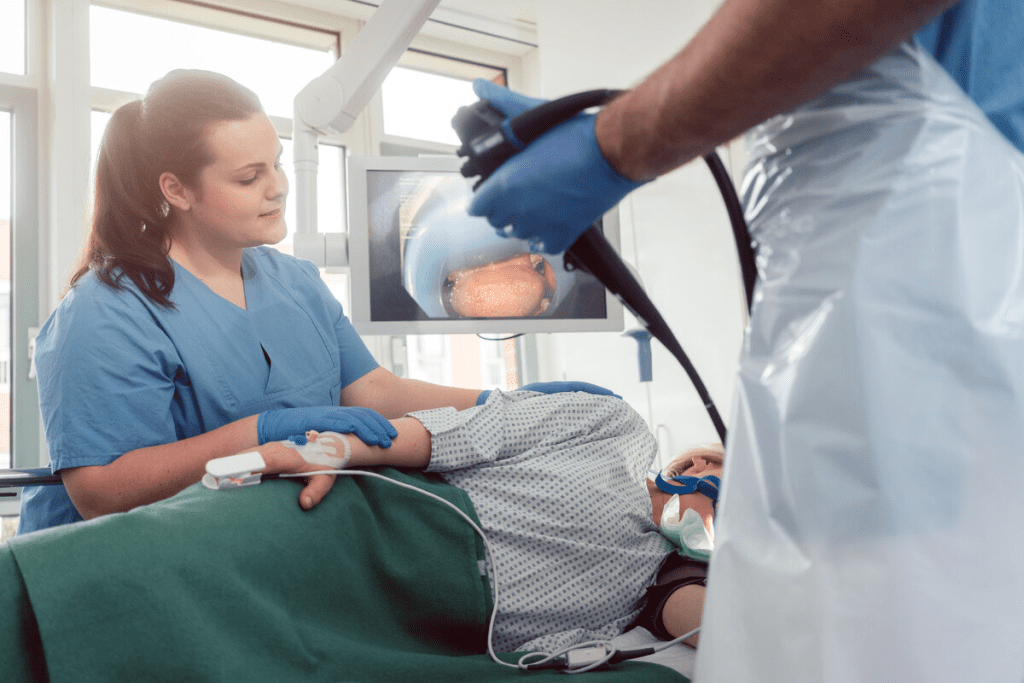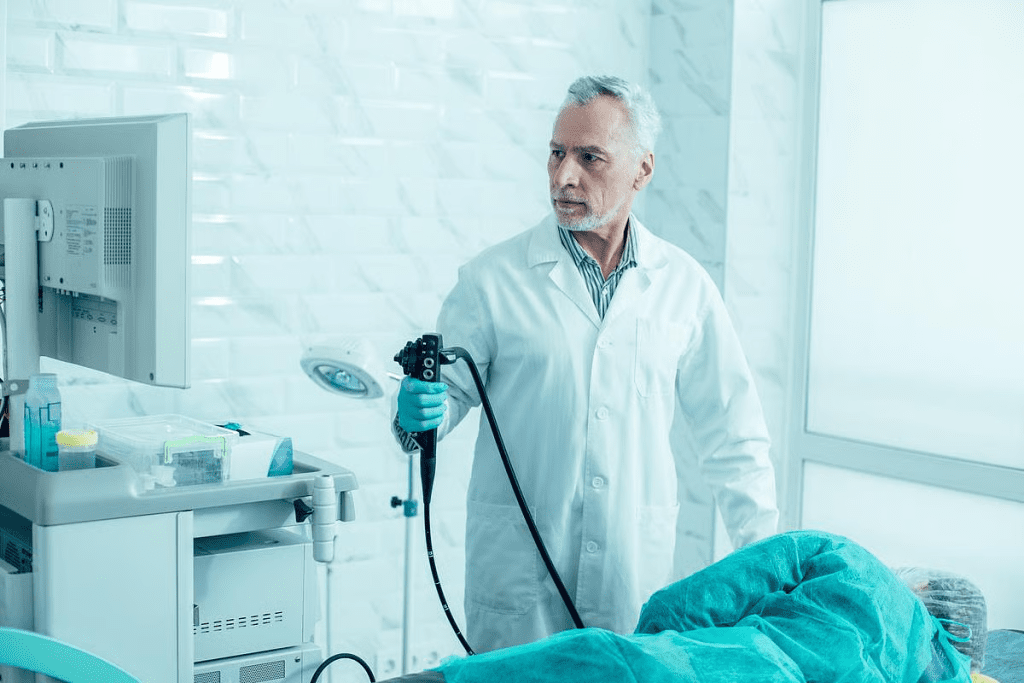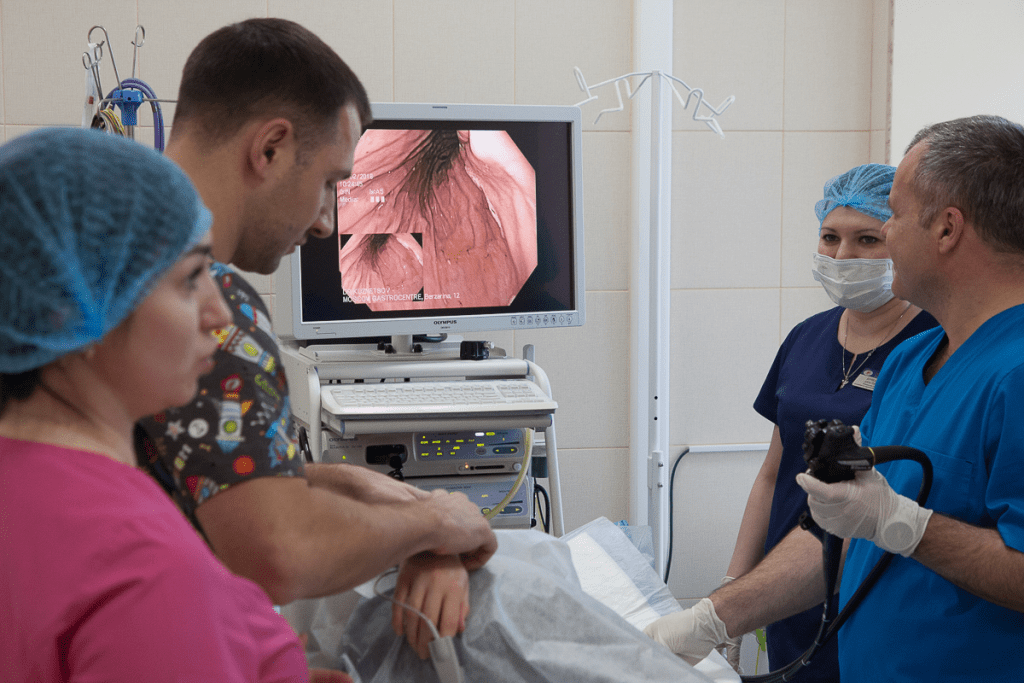Last Updated on November 26, 2025 by Bilal Hasdemir

Colonoscopy ovarian cancer detection is unlikely. Learn why and what methods are more reliable for detection.
Ovarian cancer is a big worry for women, with nearly 20,000 new cases in the United States each year. Screening is key for catching it early. But, many don’t get how colonoscopy fits into ovarian cancer screening.
A colonoscopy mainly looks for colon cancer and other gut problems. But, it can’t really find ovarian cancer. Knowing what a colonoscopy can and can’t do is important for women’s health.
Key Takeaways
- Colonoscopy is not a primary screening method for ovarian cancer.
- Understanding the limitations of colonoscopy is key for finding ovarian cancer.
- Other methods are better for spotting ovarian cancer.
- Colonoscopy is good at finding other cancers, though.
- Women should know about all the screening options out there.
Understanding Colonoscopy: Purpose and Procedure

A colonoscopy is more than a routine check-up. It’s a key tool for catching colon cancer early. This test lets doctors see inside the colon and rectum.
What Is a Colonoscopy?
A colonoscopy uses a flexible tube with a camera and light. It’s called a colonoscope. Doctors use it to look inside the colon and rectum. They check for polyps, cancer, and other problems.
The Areas Examined During a Colonoscopy
Doctors check the whole colon and rectum during a colonoscopy. This is important for finding problems early. The colonoscope moves through the colon, sending pictures to a screen.
Doctors can:
- Find polyps, which are growths on the inner lining
- Spot cancer or changes that might become cancer
- See signs of inflammation or infection
- Look for other issues in the colon and rectum
Common Reasons for Undergoing a Colonoscopy
There are many reasons for a colonoscopy. Some include:
- Screening for colon cancer: It’s key for people over 50 or with a family history.
- Investigating symptoms: It helps find the cause of symptoms like bleeding or pain.
- Monitoring after previous polyps or cancer: It’s used to check for signs of recurrence.
Knowing about colonoscopy helps people understand its role in health. It’s a vital tool for keeping the gut healthy.
Ovarian Cancer: An Overview

Ovarian cancer is a big health issue for women all over the world. It’s important to know what causes it and its symptoms. This cancer starts in the ovaries, which are part of the female body’s reproductive system.
Defining Ovarian Cancer
Ovarian cancer happens when cells in the ovary grow and multiply too much. This forms a tumor. There are different types, but most cases are epithelial ovarian cancer.
We don’t know all the reasons why ovarian cancer happens. But it seems to be caused by genes and the environment.
Risk Factors and Warning Signs
There are certain things that can increase your risk of getting ovarian cancer. These include family history, certain genetic mutations like BRCA1 and BRCA2, and some hereditary syndromes.
Signs of ovarian cancer might include bloating, pelvic pain, trouble eating, and changes in urination. But these symptoms can also mean other things, making it hard to catch ovarian cancer early.
Challenges in Early Detection
Finding ovarian cancer early is key to saving lives. But it’s hard because symptoms are not clear and there’s no good test for everyone.
Women at high risk might get special tests like ultrasound and CA-125 blood tests. This shows how important it is to know your risk.
It’s vital to understand ovarian cancer, its risks, and symptoms. By teaching women about screening and prevention, we can fight this disease better.
The Direct Answer: Can Colonoscopy Detect Ovarian Cancer?
Colonoscopy is mainly for checking the colon, not for finding ovarian cancer. It looks for colon cancer, polyps, and other colon issues. A flexible tube with a camera is used to see inside the colon.
Anatomical Considerations: Colon vs. Ovaries
The colon and ovaries are different parts of the body. The colon is in the large intestine, and the ovaries are in the pelvic area. Because of this, colonoscopy can’t look at the ovaries.
Ovaries are outside the colon and can’t be seen during a colonoscopy. So, this test can’t find ovarian cancer. The colon and ovaries being separate makes colonoscopy bad for finding ovarian cancer.
Limitations of Colonoscopy for Gynecological Cancers
Colonoscopy is for the colon and rectum, not for finding cancers outside, like ovarian cancer. Gynecological cancers need special tests, not colonoscopy.
Colonoscopy can’t see the ovaries or other reproductive organs. So, it’s not good for checking for ovarian cancer.
Why Colonoscopy Is Not a Primary Ovarian Cancer Screening Tool
Colonoscopy is not the first choice for finding ovarian cancer. Other tests like ultrasound and CA-125 blood tests are better for the ovaries.
Colonoscopy can’t look at the ovaries. This makes it not good for finding ovarian cancer.
Colonoscopy Ovarian Cancer Detection: Possibilities and Limitations
The link between colonoscopy and finding ovarian cancer is complex. Colonoscopy mainly looks at the colon. Yet, it can sometimes show signs of ovarian cancer, either directly or indirectly.
When Ovarian Cancer Affects the Colon
Ovarian cancer can spread to nearby organs, like the colon. This is not its main place to spread. When it does, it can cause changes seen during a colonoscopy. These changes might include colon wall thickening or mass lesions.
In these cases, a colonoscopy might find signs that suggest ovarian cancer.
Secondary Signs That Might Be Visible
During a colonoscopy, there can be secondary signs of ovarian cancer. These include external compression on the colon or rectum. This can happen if a large ovarian tumor presses on these areas.
Also, if ovarian cancer has spread to the colon, you might see lesions or ulcerations. While these signs are not sure proof of ovarian cancer, they can lead to more tests.
Case Studies and Exceptions
There are cases where colonoscopy was the first clue to ovarian cancer. For example, a patient getting a colonoscopy for other reasons might find something unexpected. This could lead to an ovarian cancer diagnosis.
These stories show how important it is to watch for signs that might not seem related to the colon.
In summary, colonoscopy is not the main way to find ovarian cancer. But, it can sometimes give useful clues, like when ovarian cancer affects the colon or nearby areas. Knowing what colonoscopy can and can’t do helps doctors make better choices.
How Ovarian Cancer Can Affect the Bowel
Ovarian cancer can impact the bowel in several ways as it advances. It’s important for patients and healthcare providers to understand these effects. This knowledge helps manage symptoms and improve quality of life.
Metastasis to the Colon
Ovarian cancer can spread to the colon. This can happen through direct invasion or the lymphatic system. Such spread can cause bowel obstruction or changes in bowel habits.
Key aspects of metastasis to the colon include:
- Cancer cells spreading from the ovaries to the colon
- Potential for bowel obstruction due to tumor growth
- Changes in bowel habits or abdominal pain
External Pressure on the Bowel
Ovarian cancer can also press on the bowel. Growing tumors can cause discomfort, pain, or changes in bowel function. This pressure can mimic other gastrointestinal conditions, making diagnosis hard.
The symptoms caused by external pressure can include:
- Constipation or difficulty passing stools
- Abdominal pain or cramping
- Bloating or discomfort in the abdominal region
Symptoms That Mimic Colon Issues
Ovarian cancer can cause symptoms similar to colon or bowel diseases. These include changes in bowel habits, abdominal pain, or bloating. Healthcare providers must consider ovarian cancer when patients show these symptoms, even if they are persistent or severe.
- Changes in bowel habits or consistency of stool
- Abdominal pain or cramping
- Unexplained weight loss or loss of appetite
Misdiagnosis Concerns: When Ovarian Cancer Is Mistaken for Bowel Disease
Diagnosing ovarian cancer is hard because it looks like bowel disease. Both have similar symptoms. This makes it important to tell them apart.
Similar Symptom Profiles
Ovarian cancer and bowel disease share symptoms like stomach pain, bloating, and changes in bowel habits. These similarities can cause misdiagnosis concerns. Symptoms might be wrongly blamed on the wrong condition.
- Abdominal pain and discomfort
- Bloating and swelling
- Changes in bowel habits or urination frequency
Diagnostic Challenges for Physicians
Doctors face big diagnostic challenges when dealing with symptoms of ovarian cancer or bowel disease. The symptoms are so similar that a detailed check is needed to find the right diagnosis.
A thorough medical history and physical examination are essential in figuring out the cause of symptoms. They help guide further tests.
The Importance of Comprehensive Evaluation
A detailed check is key to tell ovarian cancer apart from bowel disease. This includes imaging, lab tests, and physical exams.
- Pelvic examinations to assess for any abnormalities
- Imaging tests such as ultrasound or CT scans
- Laboratory tests, including CA-125 blood tests
In conclusion, mistaking ovarian cancer for bowel disease is a big worry because of similar symptoms. A detailed evaluation is vital for the right diagnosis and treatment.
Proper Screening Methods for Ovarian Cancer
Knowing the right ways to screen for ovarian cancer is key for women’s health. Early detection can greatly improve treatment results. Ovarian cancer is often called a “silent killer,” making it important to find it early.
Transvaginal Ultrasound
Transvaginal ultrasound is a major tool in finding ovarian cancer. It uses a special probe in the vagina to see the ovaries clearly. This helps spot any odd shapes or sizes that might mean cancer.
Benefits of Transvaginal Ultrasound:
- Provides high-resolution images of the ovaries
- Helps in detecting ovarian abnormalities early
- Can be used in conjunction with other screening methods for a full check
CA-125 Blood Test
The CA-125 blood test checks for a protein called CA-125 in the blood. High levels might mean ovarian cancer, but it’s not the only cause. It’s used with other tests to see if cancer is likely.
“The CA-125 test is not definitive on its own but is a valuable tool when used alongside other screening methods.” –
American Cancer Society
Pelvic Examinations
Pelvic exams are important for women’s health and help find ovarian cancer. A healthcare provider checks the reproductive organs, like the ovaries, during the exam.
Genetic Testing for High-Risk Individuals
Genetic testing is key for those with a family history of ovarian or breast cancer. It looks for BRCA1 and BRCA2 gene mutations. This helps spot those at higher risk early on.
| Screening Method | Description | Benefits |
| Transvaginal Ultrasound | Uses a specialized probe to image the ovaries | Early detection of ovarian abnormalities |
| CA-125 Blood Test | Measures the level of CA-125 protein in the blood | Indicates possible ovarian cancer risk |
| Pelvic Examinations | Physical check of the reproductive organs | Finds odd shapes or sizes in the ovaries |
| Genetic Testing | Looks for genetic mutations linked to ovarian cancer | Finds high-risk individuals for early action |
Imaging Tests That Can Detect Ovarian Cancer
Ovarian cancer detection uses many imaging tests, not just colonoscopy. Colonoscopy is key for the colon, but other tests are better for finding ovarian cancer.
CT Scans vs. Colonoscopy
CT scans and colonoscopy are for different things in cancer detection. CT scans show detailed pictures of the abdomen and pelvis, including ovaries. They’re great for finding ovarian cancer. On the other hand, colonoscopy looks at the colon and rectum’s inside.
CT scans can see outside the colon, like tumors in ovaries and lymph nodes. Colonoscopy can only see the colon.
| Imaging Test | Purpose | Use in Ovarian Cancer Detection |
| CT Scan | Detailed imaging of abdomen and pelvis | Highly useful for detecting ovarian tumors and metastasis |
| Colonoscopy | Examination of colon and rectum | Limited use; not designed for ovarian cancer detection |
MRI for Ovarian Cancer Detection
MRI (Magnetic Resonance Imaging) is also great for finding ovarian cancer. It shows clear pictures of female organs, helping spot tumors and see how big they are.
MRI is good at telling if an ovarian mass is cancerous. It’s also safe because it doesn’t use radiation, making it a good choice for some patients.
PET Scans and Their Role
PET scans (Positron Emission Tomography) check how active tissues are. For ovarian cancer, PET scans find areas that are very active, which might mean cancer.
PET scans work best with CT scans (PET-CT) to show both how tissues look and how active they are. This combo is great for finding cancer again and seeing how treatments work.
When Colonoscopy Might Be Ordered Alongside Ovarian Cancer Concerns
When ovarian cancer is a concern, doctors might suggest a colonoscopy. This might seem odd because colonoscopies are mainly for colon cancer. Yet, there are times when this test can offer important insights.
Ruling Out Colon Cancer
One key reason for a colonoscopy is to check for colon cancer. Symptoms of ovarian cancer can be similar to those of colon cancer. These include changes in bowel habits or stomach pain.
By doing a colonoscopy, doctors can look for any unusual growths in the colon. This could be polyps or tumors causing the symptoms.
Investigating Bowel Symptoms
Ovarian cancer can sometimes cause bowel symptoms. This is because the tumor might press on the colon or other parts of the digestive system. A colonoscopy can help look into these symptoms.
During the procedure, the doctor can check the colon for any signs of a tumor pressing on it.
Part of a Comprehensive Diagnostic Approach
A colonoscopy can be part of a wider plan when ovarian cancer is suspected. It’s not a direct test for ovarian cancer like ultrasound or blood tests. But, it can add to the overall picture, helping doctors make a more accurate diagnosis.
In short, while colonoscopy isn’t the first choice for finding ovarian cancer, it can play a role in diagnosis. Knowing when and why it’s used can help patients understand their tests better.
The Role of Biopsies in Cancer Detection
Biopsies are key in finding cancer, like the link between colonoscopy and ovarian cancer. They check tissue samples for cancer cells. Colonoscopy mainly looks at the colon, but it might also find ovarian cancer signs.
Can Colonoscopy Biopsies Detect Ovarian Cancer?
Colonoscopy biopsies don’t usually find ovarian cancer directly. They look at the colon and rectum, not the ovaries. But, they might show signs of ovarian cancer affecting the colon or nearby tissues.
Colonoscopy isn’t a replacement for tests for ovarian cancer. Tests like ultrasound, CA-125 blood tests, or pelvic exams are better for finding ovarian cancer.
When Tissue Samples Are Necessary
Tissue samples are key for cancer diagnosis, like ovarian cancer. Colonoscopy biopsies aren’t the main way to find ovarian cancer. But, they can help if ovarian cancer has spread to the colon or nearby areas.
In these cases, a biopsy takes a sample of the suspicious tissue. This helps figure out where the cancer started and what treatment to use.
Limitations of Biopsy Procedures
Biopsies are very useful, but they have limits. How accurate a biopsy is depends on the doctor’s skill, the tissue quality, and the cancer type.
For finding ovarian cancer with colonoscopy, the limits are big. The method isn’t made for checking the ovaries. So, relying only on colonoscopy biopsies for ovarian cancer is not good.
When to See a Gynecologist vs. a Gastroenterologist
Choosing between a gynecologist or a gastroenterologist depends on your symptoms. It’s important to know the difference between gynecological and gastrointestinal issues. This helps in getting the right diagnosis and treatment.
Symptom-Based Decision Making
If you have pelvic pain, abnormal vaginal bleeding, or reproductive system issues, see a gynecologist. For abdominal pain, changes in bowel habits, or gastrointestinal bleeding, a gastroenterologist is the best choice.
But, some symptoms can be tricky. For example, lower abdominal pain might be from either a gynecological or gastrointestinal problem. A detailed check is needed to figure out the right specialist.
The Importance of Specialist Referrals
Your primary care doctor is key in sending you to the right specialist. They refer you to a gynecologist or gastroenterologist based on your symptoms. This ensures you get care that fits your needs.
Specialists have the skills and knowledge for specific tests and exams. A gynecologist might do a pelvic exam and ultrasound, while a gastroenterologist might do a colonoscopy.
Coordinated Care Approaches
When symptoms overlap or involve multiple systems, teamwork is important. For example, if ovarian cancer spreads to the bowel, a gynecologic oncologist and a gastroenterologist might work together.
| Symptom | Specialist | Possible Diagnostic Tests |
| Pelvic pain, abnormal vaginal bleeding | Gynecologist | Pelvic examination, transvaginal ultrasound |
| Abdominal pain, changes in bowel habits | Gastroenterologist | Colonoscopy, CT scan |
| Lower abdominal pain (ambiguous symptoms) | Both/Initial evaluation by primary care | Pelvic examination, ultrasound, CT scan, colonoscopy |
Good communication between healthcare providers is key for effective care. Patients should ask questions and seek a second opinion if unsure about their diagnosis or treatment.
Patient Advocacy: Getting the Right Tests
Patient advocacy is key in dealing with cancer screening and diagnosis. Being informed and proactive can greatly improve your care.
Communicating Effectively with Healthcare Providers
Talking well with your healthcare provider is vital for good care. Share your symptoms, medical history, and any worries. Prepare for your appointment by writing down your questions and symptoms.
Use clear and simple language when talking to your healthcare provider. This helps avoid misunderstandings. If you’re unsure about anything, ask for clarification.
Questions to Ask About Cancer Screening
Knowing about cancer screening is important. Here are some essential questions to ask your healthcare provider:
- What cancer screening tests are recommended for my age and risk factors?
- How often should I undergo these screenings?
- What are the risks and benefits associated with these tests?
- How will the results be communicated to me, and what are the next steps if abnormalities are found?
Conclusion: The Future of Ovarian Cancer Detection
Colonoscopy is not the main way to find ovarian cancer. But, new tech is making screening better. Soon, we’ll have tests that are more accurate and reliable.
Scientists are always trying to make detection better. They’re looking at ultrasound, blood tests, and genetic tests for high-risk people. These steps are key for finding cancer early and treating it well.
The future of screening will use many methods together. This mix will help get accurate diagnoses. As we learn more about ovarian cancer, we’ll see better ways to screen for it.
It’s important for patients and doctors to keep up with new findings. Together, we can help ovarian cancer patients more. We’re moving towards a time when finding cancer early and treating it well will be common.
FAQ
Can a colonoscopy detect ovarian cancer?
No, a colonoscopy is not for finding ovarian cancer. It checks the colon and rectum for cancer and other problems.
What is the primary purpose of a colonoscopy?
Mainly, a colonoscopy looks for colon cancer. It also finds polyps and checks for colon and rectum issues.
Can ovarian cancer be mistaken for bowel disease?
Yes, ovarian cancer can look like bowel disease. Symptoms like abdominal pain and bloating can be similar.
What are the proper screening methods for ovarian cancer?
To screen for ovarian cancer, use transvaginal ultrasound and CA-125 blood tests. Pelvic exams and genetic tests are also key for high-risk people.
Can imaging tests other than colonoscopy detect ovarian cancer?
Yes, tests like CT scans, MRI, and PET scans can find ovarian cancer. They help see if it has spread.
When might a colonoscopy be ordered alongside ovarian cancer concerns?
A colonoscopy might be done to check for colon cancer. It’s also used for bowel symptoms or when ovarian cancer is suspected.
Can colonoscopy biopsies detect ovarian cancer?
No, biopsies from colonoscopy are not for ovarian cancer. They look at colon and rectum tissue samples.
How does ovarian cancer affect the bowel?
Ovarian cancer can spread to the colon or press on it. It can also cause symptoms that seem like colon problems.
When should I see a gynecologist versus a gastroenterologist?
See a gynecologist for ovarian cancer or reproductive health issues. For bowel health, go to a gastroenterologist. Getting the right specialist is key for diagnosis and treatment.
What are the limitations of colonoscopy in detecting ovarian cancer?
Colonoscopy can’t find ovarian cancer. It can’t see the ovaries or detect gynecological cancers.
Are there any scenarios where colonoscopy might indirectly relate to ovarian cancer detection?
Yes, if ovarian cancer impacts the colon or causes bowel symptoms, a colonoscopy might be part of the diagnosis.
References
- National Cancer Institute. (2023). Ovarian, Fallopian Tube, and Primary Peritoneal Cancer Screening (PDQ ®)“Health Professional Version. https://www.cancer.gov/types/ovarian/hp/ovarian-screening-pdq
- U.S. National Library of Medicine. (2023). Ovarian cancer. MedlinePlus. https://medlineplus.gov/ovariancancer.html






